2005 VOLKSWAGEN GOLF spare tire
[x] Cancel search: spare tirePage 35 of 444
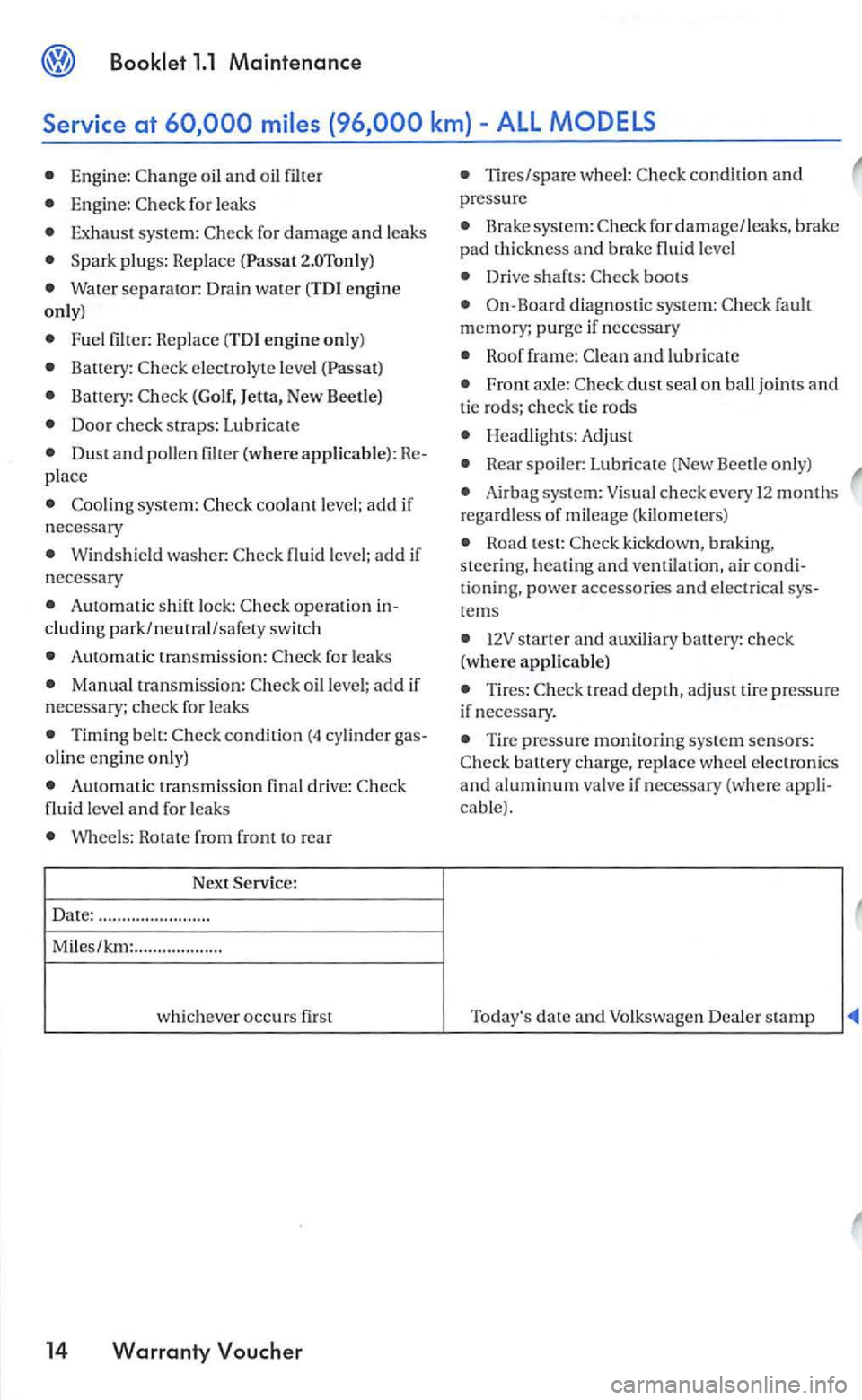
km)-All
Engine: oil and oil filter
Engine : fo r l eaks
Exhaus t sys te m :
plu gs: Replace
Water separator : Dra in wa te r (TDI engi n e
only)
F uel Repla ce (TDI engine only)
electrolyte le vel
(Golf, }etta, New Beetle)
Door check stra ps: Lubri cate
Dus t and polle n place
Windsh ie ld was her: leve l; add if
n ecessary
A uto m atic shif t lock: operation
A utomatic tra nsmission:
Manua l tran smission: oil level; add if
n ecessary; ch eck for leaks
Timing belt: olin e engin e only)
Automati c transmission final drive: level and for leaks
Wheels: Rotate from Front rear
Next Servic e:
D at
e: ... .... .... ..... ........
M
iles/ km: ...................
w hi ch ever occurs first
14 Warranty Voucher
T ires/spare wheel:
sys tem: for damage/leaks, brake
p ad thickness and brake level
Drive shafts:
O n-Board diagn ost ic sys tem: fault
m em ory; purge if necessary
and lubricate
Front axle: dust seal on ball joints and tic ro ds; ch eck tic rods
Headlights: Adjust
Hear spoiler: Lubricate (New Beetle only)
bag system:
Hoad test: kic kdown, braking, steering, heating and ve ntil ation, air
te ms
starte r and auxiliary bauery: check
(w here applicable)
tread depth, adj ust
Tire pressure monitoring system senso rs: bauery ch arge, re pla ce wheel ele ctron ics and a lu minum va lve if necessary (where cable).
Tod ay's date and Volkswagen Dea le r sta m p
Page 38 of 444
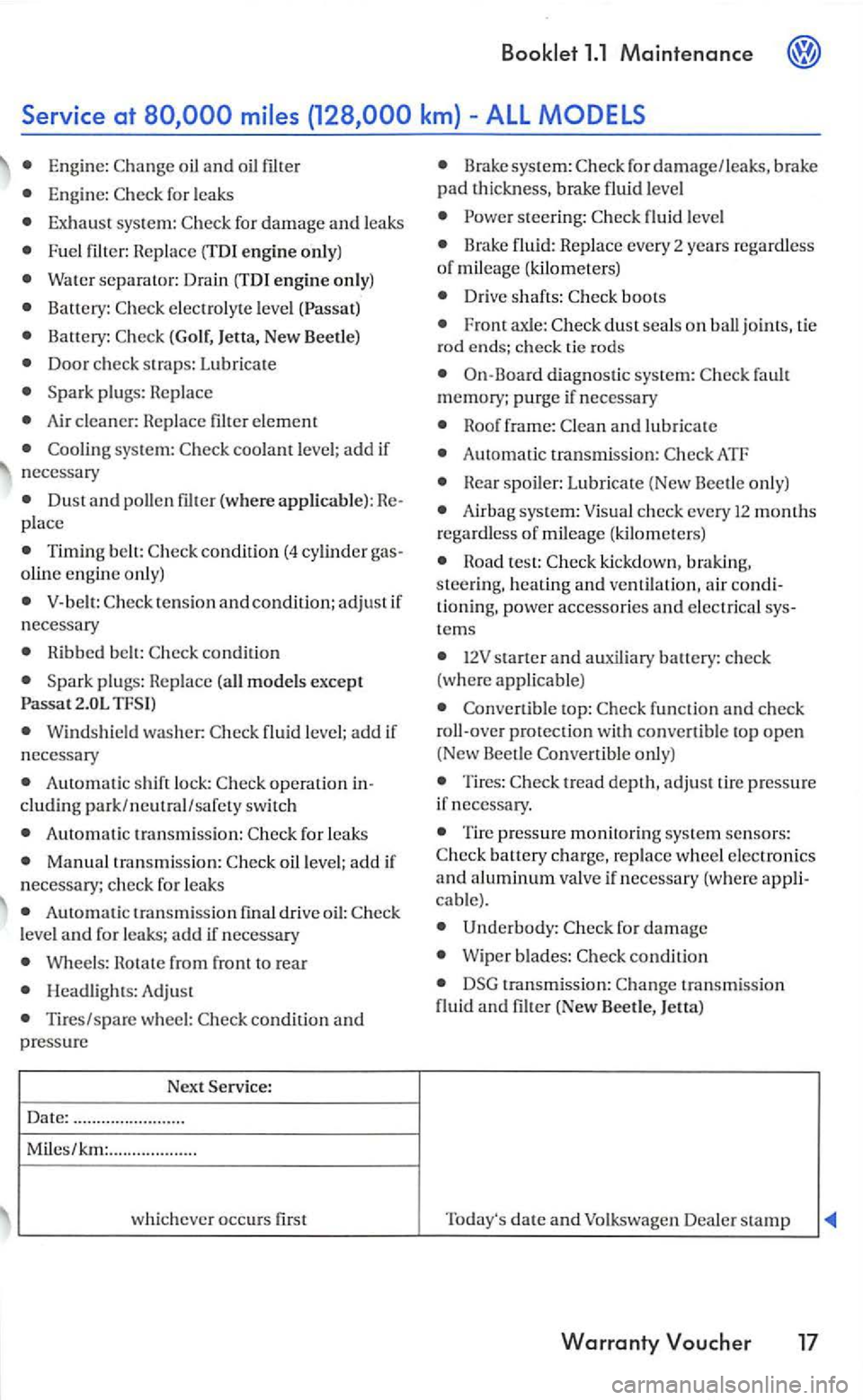
Booklet 1.1 Maintenance
oil and oil
for l eaks
for damage and leaks
engine only)
Water separator: Drain (TDI engine only)
Battery: electrolyt e leve l
Door check straps: Lubrica te
S pa rk p lugs: Replace
Air cleaner: Replace filter element
syste m : coolant leve l; add if
necessary
Dust and pollen (where applicable) : Replace
Tim ing belt:
V-be lt: tension and condition; adju st if necessary
Ribbed belt:
Spark plugs: Replace models except
Passat TF SI)
Wind shield washer: fluid level; add if
necessary
Auto matic shift lock:
Automatic transmiss ion: for leak s
oil leve l; add if
n ecessary; check for leak s
Automatic transm ission fmal drive oiJ: leve l and for leaks; add if necessa ry
Wheel s: Hotate from front to rea r
Hea dligh ts: Adjust
Tires/spare wheel: condition and pressure
Next S ervice:
Date: ....................... .
Miles/km: .................. .
whic hever occurs
first
Brake system: for damage/leaks, brake pad thickness, brake fluid leve l
steering: fluid leve l
boots
dust sea ls on ball joints, tie
rod ends; ch eck tie rod s
On-Board diagnostic sys tem: fault
m emory; purge if necessary
and lubricate
Automat ic transmission:
Air bag syste m: Visual check every 12 months
r egard Jess of mileage (kilometers)
Convertible top: function and check
roll-ove r protection convertib le to p open (New Beet le
tread deptJ1, adjust tire pressure
if necessa ry.
Tire press ure monitoring system sensors: battery ch a rge, replace wheel electronics
and aluminum valve if necessary (where applicable).
Underbody: f o r damage
W iper blades: con ditio n
transmission: tra nsmission fluid and filter (New Beetle, }etta)
T oday's
date and Volkswagen DeaJer stamp
Warranty
Page 41 of 444
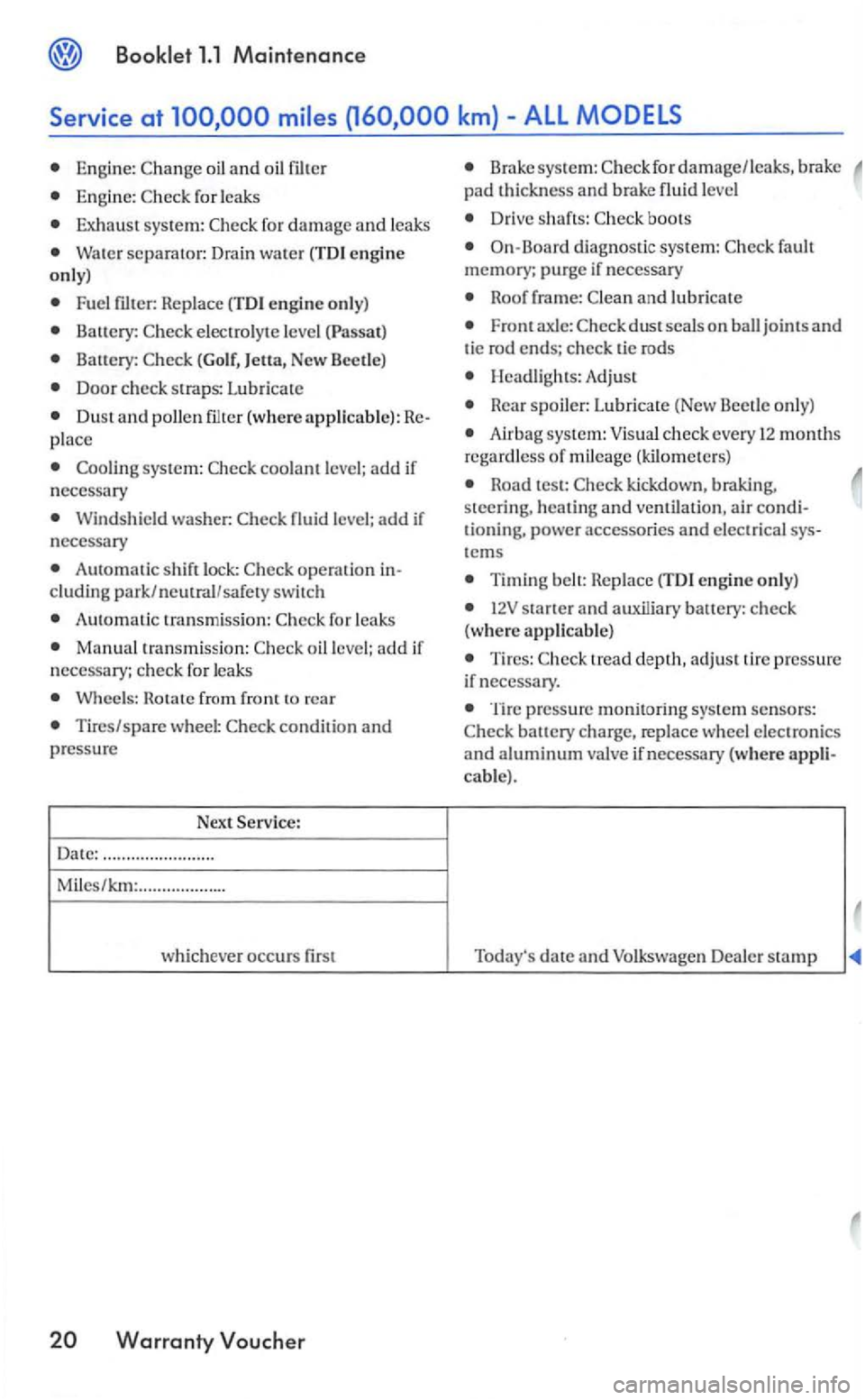
Engine: oil and oil filter
Engine: for leaks
Exhaust system: fo r damage and leaks
Water separator: Drain water (TDI e ngi ne only)
Fuel
electrolyte level
Battery: (Golf, )etta, New
Door check straps: Lubricate
s ystem:
Windshield washer:
Automatic sh ift lock:
Automatic transmiss ion:
Manual transmiss ion:
Wheels:
Tires/spare wheel :
Date: .................. ... ...
Miles/km: .................. .
which ev
er occurs first
Brake system: for damage/leaks, brak e pad thickness and brake fluid
Drive shafts: boots
On-Board diagnos tic system: fault
memory; purge if nece ssary
Roof frame: and lubricate
Front axle: jo int s and tie rod ends; ch eck tie rods
Hea dligh ts : Adjust
Rear sp oile r: Lub ricate (New Beetle only)
Airbag system: Visual check every 12 months regardless of mileage (kilom eters)
Road test: kickdown , braking, steering, heating and ventilation , air conditioning, powe r accessories and electrical systems
Timing belt: Replace (TDI engine only)
starter and auxiliary banery: check
( w here applicable)
T ires: tread dept h, adjust tire pressure
if nec essary _
Tire pressure monitoring system sen sors: battery charge, replace wheel electronics and aluminum valve if necessary (whe re appli
cable) .
date and Volkswagen Dealer stamp
Page 338 of 444
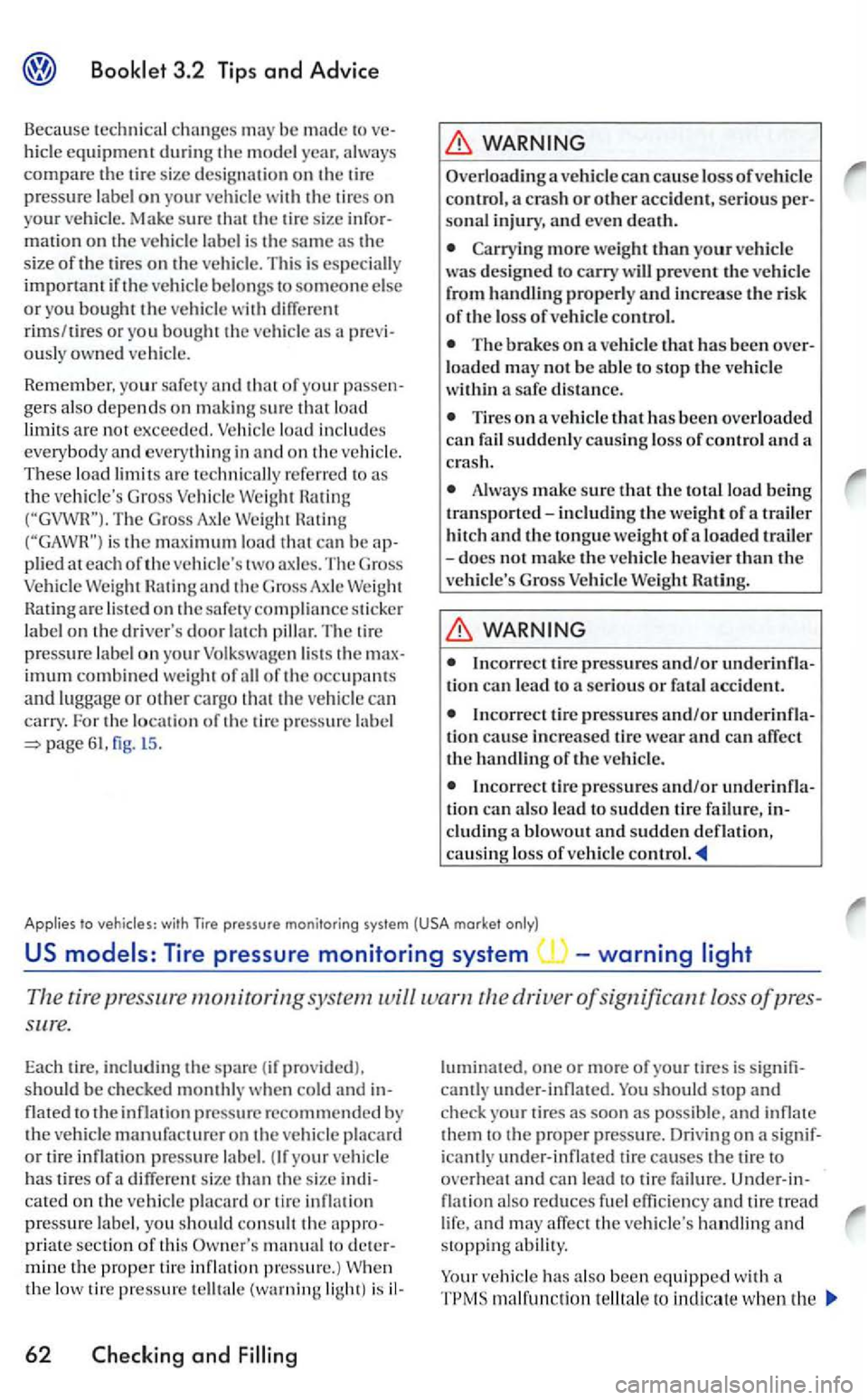
3.2 Tips and Advice
Because technical changes may be made to vehicle equipment during the model year, always compare the tire size desig nation on the tir e pressure label on your vehicle with the tire s on your vehicle. Make sure
a previousl y owned ve hicle.
Remember, your safe ty and t h at of your passengers also depends on making sure that load
limit s are not exceeded. Vehicle load includes everybody and everything in and on the vehicle.
T hese load limit s arc techni call y referred to the ve hicle's Gross Vehicl e Rating Hatin g is th e maximum load that
Hating are listed on th e s afet y compliance sticker
label on t h e driver's door
fig. l5 .
WARNING
Overloading a vehicl e can cause loss of vehicle control,
more we ight than your vehicle was des ign ed to carry w ill prevent the vehicle from handling properly and increase the risk of the loss of vehicle control.
The on a vehicle that has been over
loaded may not be abl e to stop the vehicle within a safe distance.
Tires on a vehicle that has been overloaded can fail suddenly cau sin g loss of control and a crash.
Always make sure that the total load being transp o rted-including the weight of a trailer hitch and the to ng u e weight of a loaded trailer -docs not make the vehicle heavie r than the vehicle's Gross Vehicle
WARNING
Inco rrect tire pressures and/or underinflation can lead t o serious or fata l accident.
Incorrect tire pressures and/or underinflation cause increased tire wear and can affect the ha nd lin g of the ve hicle.
Applies to
The tire pressur e monitoring syste m driver ofsignificantloss of pres
sure.
Each tire, including the spare ( if provided),
should be c heck ed
your vehicle has tire s of a diff erent s ize than the s ize indi cated on the vehicle placard or tire inflation pressure lab el, you should consult the appropriate sec tion of this
and
luminatcd. one or m ore of your tires is signifi
cantly under-inflated. should stop and check your tires as soon as possible , and inflate them to the pro p er p ressure. Driving on a sig nif
icantly under- inflated tire causes the tire to overheat and can lead to tire failure. Under- in-
flation al so reduces fuel effic iency and tire tread life , and may affe ct th e vehic le's handling stopping ability.
ve hicle has also been equipped with a malfunction te llt ale to indi cate when
Page 342 of 444
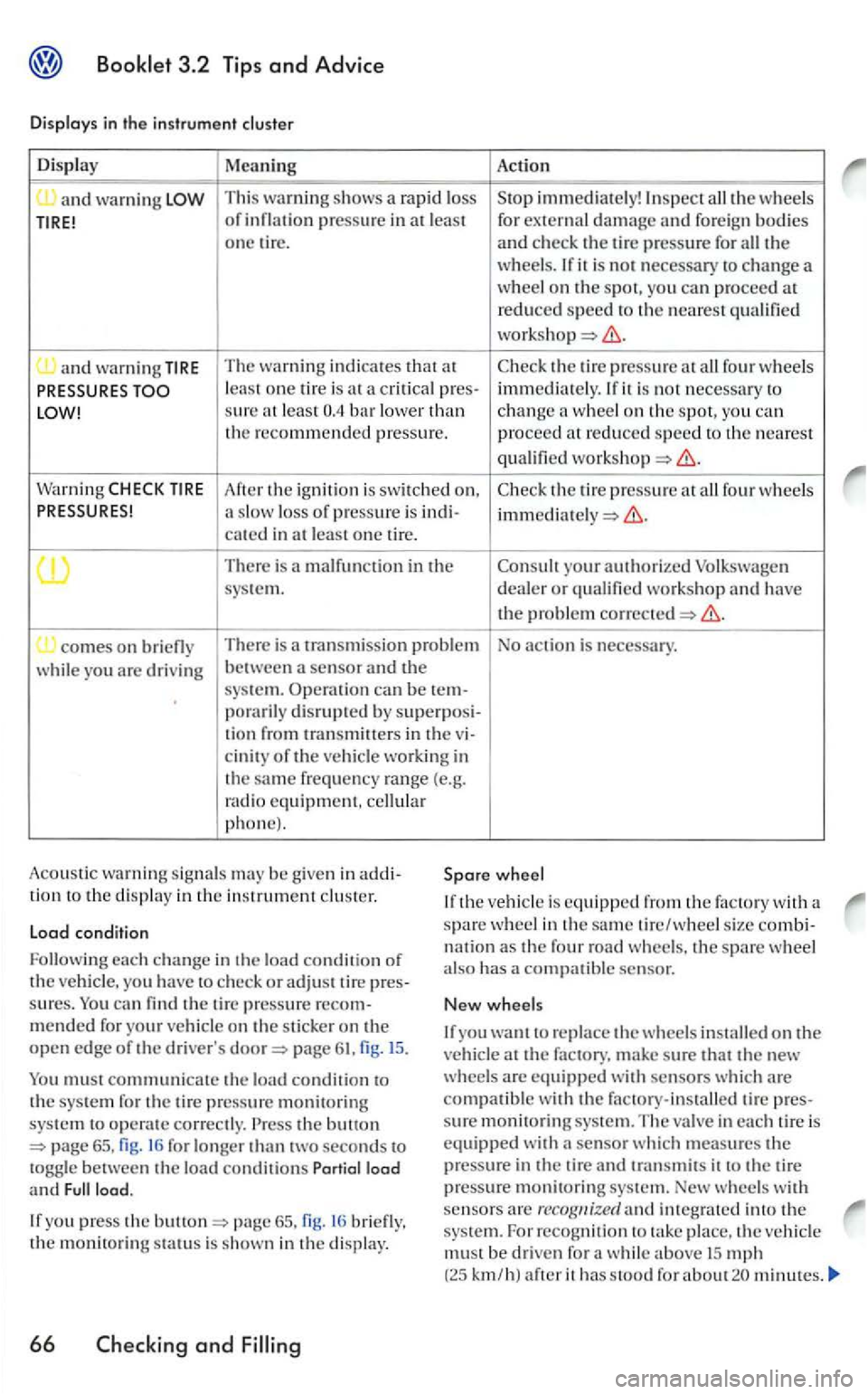
3.2 Tips and Advice
Displays in the instrument
Display Meaning Act io n -and warni ng T hi s warning shows a rapid loss immediately! In spect the wheels of p ressure in least for external damage and for eign bodies
o ne tir e. and check th e tire pressure for th e wheels. If it is not necessary to change a wheel on the spot, you pro ceed at
reduced s p e ed to the nea re st
and warnin g TIRE The warning ind ic a tes that at Check th e tire pressure at four wheels
sure at least
Warn ing After the ignition is switched on. Check th e tire pressure at four wheels a slow loss of pressure is in di-ca tcd in at le a st one tire.
T here is a malfunction in the your authorized Volkswagen
sys tem. dealer o r
comes o n
disrupted by superposi-
tion from transmi tters in the
the same frequency range (e.g.
rad io equipment. phone).
Load condition
Followi ng
each change in th e load conditio n of
th e yo u have check or adjust tir e sure s. can
page
mus t communicate th e load condition to the sys te m for the tire pressure monitoring system to operat e correctly. the bullon 16 for lo nger th an two seconds to
If you press the bullon briefly. th e monitoring status is shown in the display.
66
wheel
If the vehicle is equipped the fac tory with a
spare wheel in th e same tire /wheel s ize
you re place the w heels o n the at the factory. make sure that the new
w heels are equipped with se nsors whic h are compatible with the factory-installe d tire sure monitoring sys te m. The val ve in each tire is equipped with
mus t be dri ven for a while above mph (25 km/h ) after it has s tood fo r about
Page 345 of 444
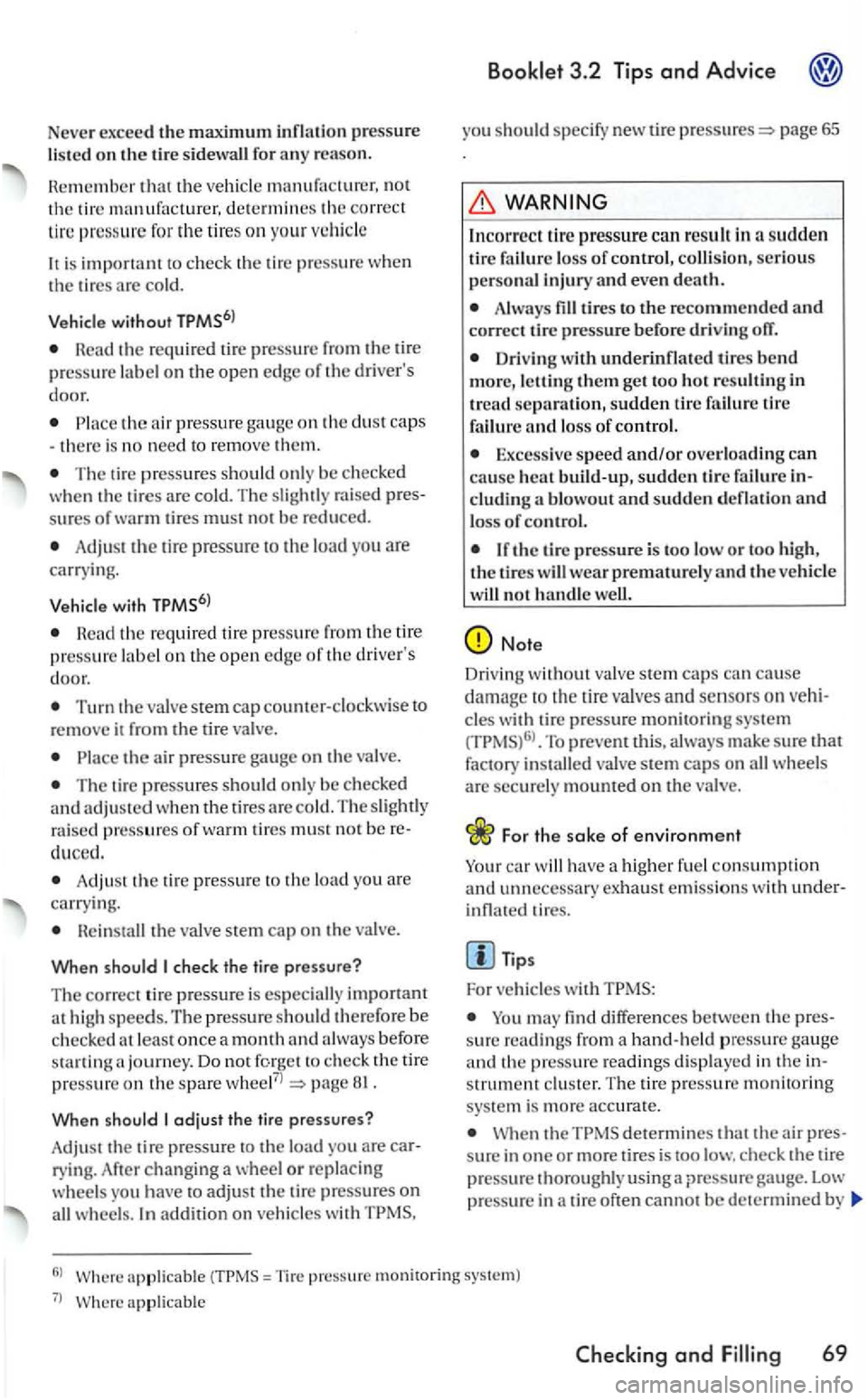
Never excee d the maximum inflation pressure listed o n the tire sidewall for
that the ve hicle manufacturer. no t the tir e m anufacturer. determines the co rrect
tir e
pressure for the tire s on your vehic le
the required tire pressure from the tire pressure label on the open ed ge of the driver's
door.
Place the air pressure gauge on the dust caps -the re is no need
The tire pressures should only be ch ecked when the tires are co ld. T he s lightl y raised pres
sures of warm t ires mus t not be red uced.
Adjust the tire pressure to the load you are
carrying.
Vehicle with
Head the required tir e pres sure from the tire
pressure on the ope n edge of the driver's
d oor.
Turn the va lve stem cap counter-cloc kwise to
remove i t from the ti re va lve.
Place the air pressure gauge on the valve.
The tire pressures should onl y be c hecked and adjusted when the tire s are cold. The slightl y
raised pressures of warm tires must not b e re
duced.
Adju st the tir e pressure to the load you are
carryin g.
the valve stem cap on the valve.
When should check the tire pressure?
The correct tire pressure is especi ally important
at high speeds. The pressure sh oul d there fore be ch ecked at least once a month and always before
s tarting a journey. Do not forge t check the tire pressure on th e spare whee l7l
When should odjust the tire pressures?
Adju st
the tire pressure to the load you are car
ry ing. Af ter changing a
addition on vehicles with TPMS,
yo u should sp ecify new tire
sudden tire failure loss of control, collision, serious personal injury even death.
Always fill tires to the recommende d and correct tire pressure before dri ving ofT.
Driving with underinflated tires bend m ore, letting them get too hot resulting in
tread separation, sudden tire failure tire
failure and loss of control.
Excessive speed and/or overloading can heat build-up, sudden tire failu re including a blowout and sudden deflation and
loss o f co ntrol.
If the tir e pressure is too low or too high, the tires w ill wear prematurely and the ve hicle
will not handle we ll.
with tire pressure monitoring system To prevent this, make sure that factory
For the sake of environment
Tip s
For vehicles
may find differences between the pres
s ur e read ings fro m a hand-held pressure gauge
a nd the pressure readings disp laye d in the in
s trument The tire pres sure monitoring syste m is more acc urat e.
the is too
applicable =Tire press ure monitoring
applicable
69
Page 349 of 444
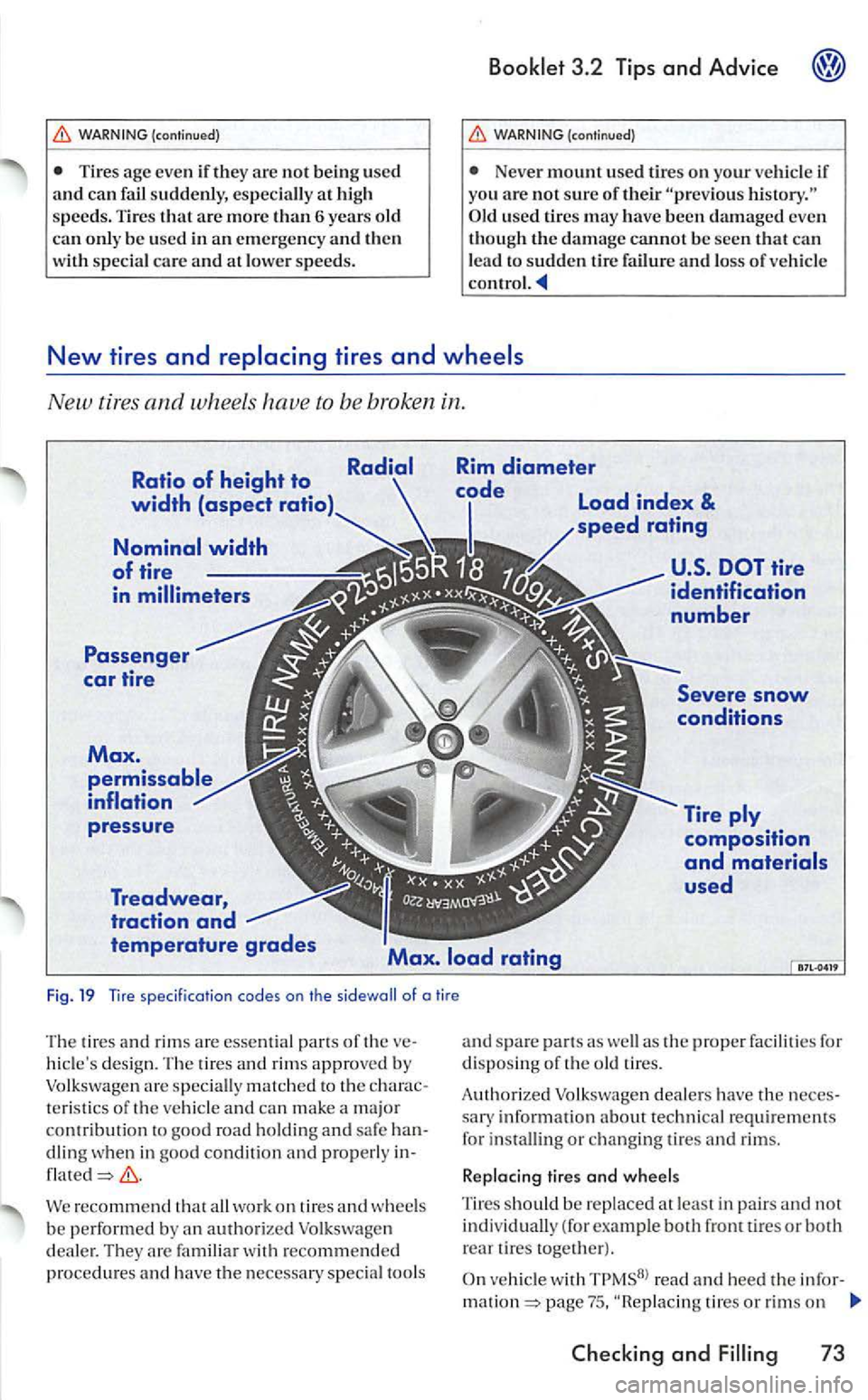
(continued)
T ires age even if they arc not being used
and can f ail suddenly, especially at high
s peeds. Tire s that are more than 6 years old can only be used in an emerge ncy and then special care and at lo we r speeds.
(continued)
Never mount used tires on yo ur ve hicle if yo u are not sure of their used tir es may have been damaged eve n though the damage cannot be seen that can lead to sudden tire fa ilure and loss of vehicl e control.
Ne w tires and wheels have to be broke n in.
Ratio of height to width (aspect ratio)
of tire - Load
index &
speed rating
in
hicle's design
. The tires and rim s approved by Volk swagen are specially matched to th e te ristics of th e ve hicl e and can make a major comribution to good road ho ldin g and safe
We recommend that all wo rk on tires and wheels be performed by an authorized Volkswage n dealer. They arc famil iar with recommended procedures and have the sp ecial tools
and spare pa rts as well as the proper facilit ies for disposing of the old tires .
Author ized Volkswage n dealers have
the sary info rmation about technical requirements for installing or changin g tires and rims.
R
eplacing tires and wheels
Tires should b e replaced at lea st in pairs and not
individuall y (fo r example both front !ires or
ve hicle with read and heed th e page 75,
Page 351 of 444
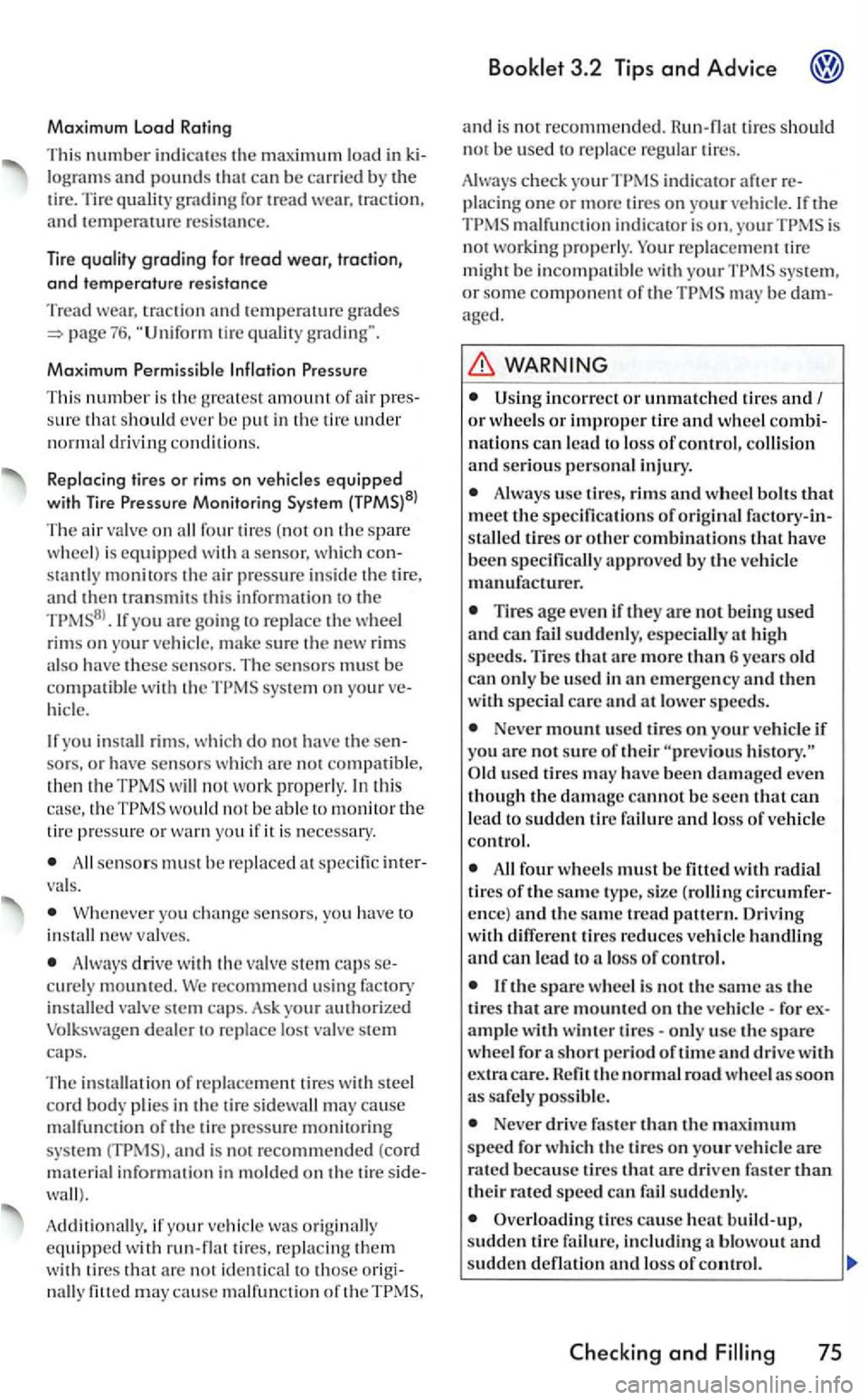
Maximum Load Ratin g
This number indi cates the maximum load in and pounds that can be carried b y th e
tire. Tire
and temperature resistance.
Tire quality grading for tr ead wear, traction,
and temperature resistance
Tread trac tion tempe rature grades
Maximum Permissibl e
su re that sh o ul d ever be put in t he tir e under normal driv in g con d itio ns.
Replacin g tire s
or rims on
stantly monitors the air pressure in sid e the tire , and then transmit s thi s information to th e
you arc goin g to replace the wheel
rims on your ve hicl e, have these se n sors. The sensors must be compatibl e with the sys te m on yo ur hicle .
you rims. which do not sors, or have sensors w hi ch are not compatibl e,
then the TPM S will no t wo rk properly. wo uld not be able to monit or the tir e pressure o r you if it i s necessaty.
senso rs mus t b e rep laced at sp ecific va ls.
yo u ch an ge sen sors, yo u have to new valv es.
driv e wi th the stem caps curely m ounted . valve stem caps. your authorized Volk swage n dealer to re p lace lost va lve stem caps.
T he in stallat i
on of replacement ti res w ith steel cord p lie s in th e tire sidewal l may cause m alfuncti on of the tire pressure monitoring sys te m and is no t recomme nded (cord material inform ation in molded o n the tir e
if your ve hicle was equipped with r un-flat tires. rep la cin g them
wi th tire s that are not identical to th ose fill ed may cause mal function of the
3.2 Tips and Advice
and i s not recommended. Run-flat ti res should not be used to replace regular tires.
indicator after p la cing o ne or more tire s on you r ve hicle. the m alfu nctio n indi cator is is
not working p ro perly. Your r eplacement tire
m ight be incompatible with system,
o r some component of the be age d.
Usin g incorrect or unmatch ed tires and I or wheels or imprope r tire and wheel
use tires , rims and wheel b o lts that meet the sp ecificatio ns o f o ri ginal
Tires age even if they are n o l b eing used and can fail suddenly, especially a t hi gh
s peeds. Tires that arc m ore tha n 6 years old can only be used in an em erge ncy and then
w ith special care and lower speed s.
Never moun t used tires o n your ve hicl e if you are not sure o f their
four whee ls mus t be fitt ed with radial tires o f the same ence) and the same tread pattern. Dri ving with different tires reduces vehicle and can lead t o loss of contro l.
If the s pare wheel is no t the sam e as the tires that are m ounted on the vehicle-fo r ample with winter tires-on ly usc th e spare w heel fo r a short perio d of t im e and drive with extra care. Refit the normal road w heel as s oo n
a s safe ly possibl e.
Neve r drive fa ster th a n the maximum
speed f or which the tires on your ve hicl e are
r a te d because ti res that are driven faste r than their ra te d speed can suddenly.
Ov erloading tires cause heat build -up,
sudde n tire failure, including a blowout and sudden d eflati on and loss of control.